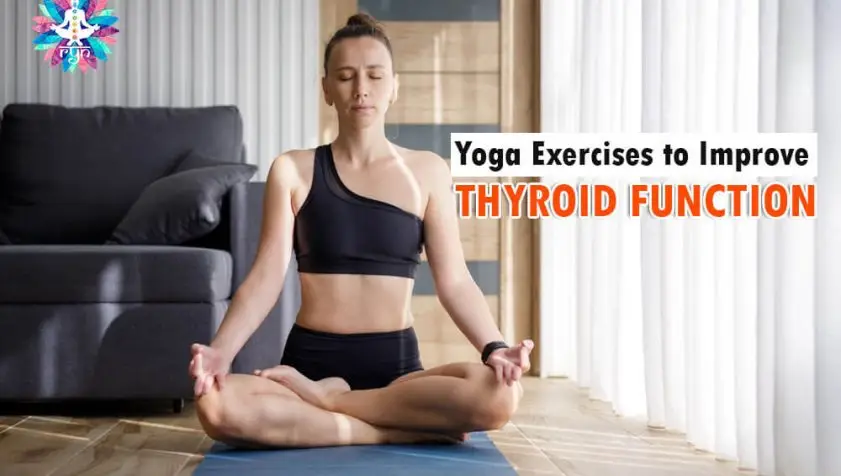
Get A Free Quote

There are different glands within our system that are responsible for producing hormones regulating certain functions of the body. Here, we like to mention that thyroid hormones are produced by the thyroid gland located in our neck, and these hormones are accountable for controlling our metabolism. Complications might arise due to too little or too much thyroid hormone. It will be feasible to balance the levels of this hormone with the help of exercise, diet, and a healthy lifestyle.
It will be feasible to treat the thyroid in a simple and effective way by practicing yoga. It has been found by research that it is possible to reduce the levels of stress by practicing yoga regularly which will impact the secretion of the thyroid gland indirectly. Below, we have fleshed out the most notable yoga asanas that will help to improve the functioning of your thyroid.
Sarvangasana or shoulder stand helps in the enhancement of blood circulation to different parts of the upper body, and this simple yet effective yoga pose is recommended for treating thyroid. While performing this pose, you simply need to lie on the bed and your legs have to be raised vertically. You also need to use your hands for supporting the lower portion of your body. While executing the Sarvangasana pose, you need to synchronize your breathing with the movements made by you.
We also call this pose the cobra pose. It helps to stretch the throat area for providing relief to it and increases the function of the thyroid as well. Individuals struggling with back pains are benefitted from this pose to a great extent. It will be suggested to avoid performing this yoga pose in case you are suffering from an ulcer or hernia.
Lie down flat on your abdomen with the palms facing the downward direction and the hands beside your rib cage. Raise your upper body while inhaling by pressing on the palms. This must include your head, shoulders, and chest. In this case, there is no need to keep your arms straight. However, it will be a good idea to bend your elbows to some extent. Maintain this pose for 30 seconds while breathing normally. Bring down your body after gradually releasing the pose.
The plough pose plays an important role in controlling the generation of hormones by the pituitary and thyroid glands. In this way, it will aid in stimulating the thyroid effectively.
Lie down on a yoga mat on your back. Make sure to support the shoulders by placing a rolled towel or blanket under the neck. Keep your head on the mat and your shoulders have to be brought to the edge of the blanket or towel. Place your arms on both sides while the palms are facing down. Raise your legs at 90 degrees from the yoga mat while breathing in. Raise the legs further while exhaling and bring them on top of your head. Make use of your hands to provide support to the lower back. Your shoulders have to be pushed into the mat with your legs going behind your head. Make sure to place the toes at the back of your head on the mat. While placing the toes on the yoga mat, inhale deeply 3 times. Breathe deeply while bringing your legs back on top of your head. Place the arms on both sides after removing them from the back. Lower your legs gradually on the yoga mat while exhaling.
This pose is also referred to as the fish pose. The circulation of blood is increased in the thyroid gland by the arch of your back and this is accountable for stimulating the thyroid gland and the neck for getting rid of any tension. It likewise helps to get rid of stress and improve posture.
Extend the legs in front while sitting on the mat. Your hands are to be placed beneath the buttocks and you need to face the palms down while the fingers must point in the direction of the toes. You need to make a right angle between your chest and the arms. Raise your chest gradually while pressing into the arms. Stay in this condition for some time and the position has to be released gradually.
We also call this pose the bridge pose that helps to control the thyroid hormones by benefiting individuals with hyperthyroidism indirectly. SetuBandhasana helps to enhance the circulation of blood in our brain thus helping it to relax effectively.
After lying down in the floor, bend the legs. Your hands must come in contact with the heels and you need to elevate your upper body as well. Maintain this pose by lifting your buttocks and keeping your fingers interlaced. No pressure must be exerted on your neck, shoulders, or chin. Make sure to stay in this position for approximately 30 seconds while breathing normally.
We also call this particular pose the upward bow pose. It aids in treating hypothyroidism by providing energy to your thyroid gland.
Lie flat on the back and your legs have to be folded at the knees while bringing the heels close to the buttocks. Your toes must face straight and the knees must point in the direction of the ceiling. Your hands have to be curved in the direction of your head and your palms have to be rested while facing in the downward direction beside your head. It is imperative for your feet not to exceed your hip distance. Exhale while putting pressure on the feet and raise your buttocks and back while breathing in. Raise the crown of your head while keeping your thighs firm. Make sure to make your arms straight after becoming comfortable and get rid of all the forces on the throat. Allow it to hand back while breathing normally. The position has to be released gradually for avoiding any jerks and you need to return to the original pose.
This pose will be responsible for improving thyroid health as well since it will assist in stimulating the thyroid glands. If you draw your chin into the chest and expose your throat chakra, it will help to enhance the circulation of blood in this area.
Make sure to kneel on the ground for executing this pose and your hands have to be placed on the ground. Your hands should be kept apart from each other and you must place your knees below the hips. Curve the lower back while breathing in deeply and tilt your pelvis up similar to a cow while bringing up your head. Bring in your abdomen while breathing in deeply and bring down your pelvis and head similar to a cat after arching your spine.
We also call this pose the corpse pose which will aid in increasing internal awareness and deep relaxation. Performing this pose can be quite difficult although you simply need to lie on the ground. Shavasana is recommended for individuals suffering from hyperthyroidism.
Lie on the back flat on the ground while keeping your toes apart. Allow the palms to face the ceiling while bringing your arms away from your body. Keep your head, spine, and neck in a straight line. Make certain to relax completely. Breathe gradually while supporting the knees if needed with a pillow.
The name of this pranayama has been derived from that of the black Indian bee named Bhramari. This is because, the action of breathing out resembles the humming noise made by a bee. This asana aids in relaxing the mind to a great extent and it also makes us free from any kind of anxiety, anger, frustration, or depression. Moreover, the good thing is that thispranayama is also beneficial for the treatment of thyroid.
Use your thumb to keep your ears closed while placing the index finger on your temple. Make use of the remaining 3 fingers to close the eyes. Following this, breathe in gently via the nose while holding for several seconds. Breathe out while making a humming noise by keeping your mouth closed.
Make it a point to perform these aforementioned yoga exercises for enhancing the health of your thyroid. However, it is also important to lead an active lifestyle along with a healthy and balanced diet. These yoga poses will be beneficial for elderly people, pregnant ladies, and those struggling with persistent health issues as well as kids.